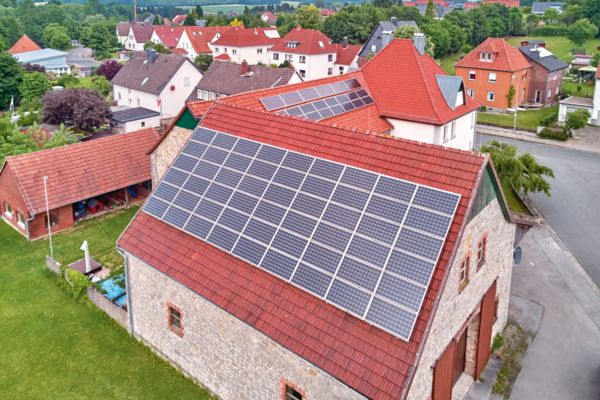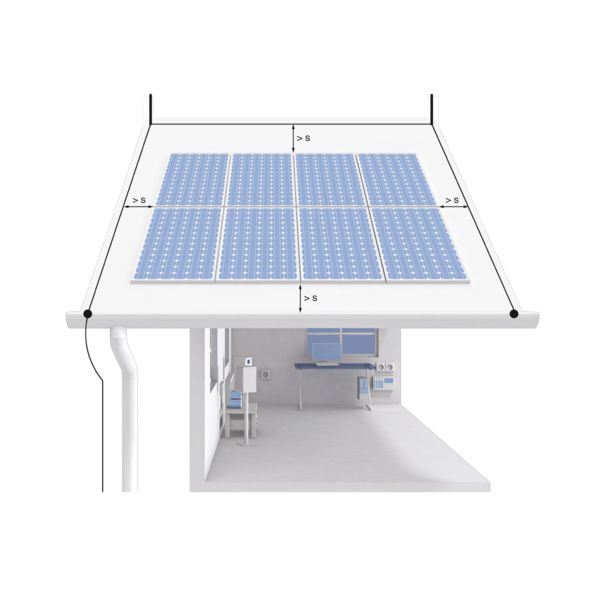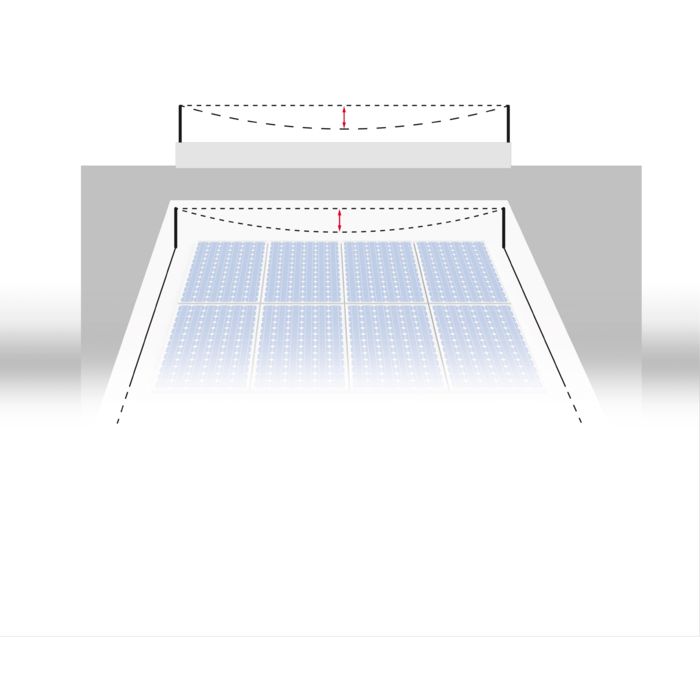External lightning protection and photovoltaic systems The functionality of the external lightning protection and the photovoltaic system must be ensured. Find out about surge protection for photovoltaic systems and download the brochure.

External lightning protection and PV systems
When a PV system and an external lightning protection system meet, they often come into conflict: both must share the roof area. The PV system and lightning protection system can be installed at the same time without any problems. If a photovoltaic system is subsequently placed on a roof area where a lightning protection system is already installed, there are several aspects that need to be considered. It is important to ensure the functionality of the external lightning protection and also the effective protection of the PV system provided by the lightning protection.
Separation distances
When current flows through a conductor, a voltage drops along the conductor. The extent of this voltage drop depends on such factors as the cross-section, form, and material of the conductor, the laying method for the conductor, or the amplitude and form of the current.
When lightning strikes the lightning protection system, the lightning current flows through the lightning conductor into the ground. A voltage thus drops along the protective device. There are several methods to calculate this. For simplicity, let’s assume a value of 1,000 V per meter. At a height of 10 m, there is therefore a voltage of 10,000 V between the lightning conductor and other grounded parts, e.g., the grounded frame of the photovoltaic system. As a result, there is a risk that the lightning will jump from the lightning conductor to the PV system. To prevent this, the lightning conductor and the PV system must be far enough apart from each other. Separation distance “s” is the minimum distance that must be observed between the lightning conductor and photovoltaic system for the lightning not to flash over.
There are many factors that make it difficult to determine the separation distance. An expert in lightning protection systems can help you with this and should therefore be involved in the planning stage.
Once the separation distance is known or has been determined, all the components of a PV system must maintain this minimum distance from the lightning protection system at every point. If it is not possible to observe the distance accordingly, the entire PV system must be connected to the external lightning protection.
With this installation, lightning currents no longer bypass the building, instead they are routed through it. The building therefore also requires a higher level of protection against overvoltages with type 1 surge protective devices.

Separation distances for photovoltaic systems

Illustration of sag
Sag
Along with the separation distance, the sag also needs to be taken into consideration, especially when retrofitting PV systems. Imagine a straight line between the tips of the lightning rods.
The area below this line needs to be protected. Physically, however, the lightning can also dip slightly below this line. This area is the sag.
To be safe from lightning strikes, the PV panels must be located below the sag. The size of the sag can be determined by the installer of the lightning protection system.

Illustration of sag for a rooftop system
If the PV panels sit above the sag, there are two options:
- The PV panel is installed so that it sits lower.
- The installer of the lightning protection system adapts the lightning protection system.
Shading
In order for the external lightning protection system to function, material is needed on the roof, which casts shadows when the sun shines, e.g., the lightning rods. The shadows cast on PV panels are referred to as shading.
Shading has a negative impact on the yield of the PV system. Depending on the size of the shaded area and the number and interconnection of affected panels, performance is reduced in the string or the entire system. This means that less power is generated than if there was no shading. In the long run, this can significantly cut profits.
Hot spots are another phenomenon, especially where there are small areas of shading, e.g., from lightning rods. They are caused by more intensive heating of the shaded areas compared to the surrounding parts of the panel that are directly exposed to the sun. There are two reasons for this:
The shaded area is no longer generating power. Previously a source, it now becomes a resistor that only conducts the current of the surrounding cells. The energy needed for this is largely dissipated as heat.
The lightning rod acts like a lens on the sun’s rays. This means that the sunrays are concentrated at the edge of the shading on the panels, thereby increasing the intensity of the sunlight in these particular spots.
Overheating is a factor that greatly contributes to the degradation of PV panels. The cells that are repeatedly exposed to this overheating are destroyed by it, thus reducing the yield of the PV panel. The ultimate extent of this influence on the functionality of the PV panels and the speed at which this effect occurs is still being discussed among experts.
The aim is to avoid the shading of the PV system by external lightning protection elements.
Cable routing
The PV panels are connected to the inverter. They are connected in series for this purpose. This installation creates a ring from the inverter to the individual modules and back to the inverter. Each of these cable rings is also an antenna and is therefore sensitive to couplings. This is ultimately because energy is coupled into the PV system through the cable ring, which may be strong enough to cause significant damage to the inverter as well as the PV system.
During cable installation, you should therefore make sure that as little energy as possible can be coupled into the PV system. The coupled in energy relates to the area spanned by the cable ring: the larger the area, the more energy that is coupled in

The cable routing looks aesthetically pleasing, but it spans a large area. In the event of a lightning strike to the building or in its proximity, there is strong interference in the PV system.

Cable routing of a photovoltaic system spanning a smaller area
The spanned area is kept as small as possible. Coupling caused by a lightning strike is significantly reduced.
How does the energy actually get into the antennas? A transmitter is needed for this. Lightning is a very strong transmitter. In simple terms, lightning is a current that flows through a conductor (not metal, but plasma in this case) from one cloud to another or to the ground.
The average lightning event in Europe involves currents of between 10,000 A and 30,000 A. Even currents of several 100,000 A can occur, albeit rarely. If lightning strikes in the proximity of the PV system or it strikes the lightning protection system, the transmitter is in the immediate vicinity. It is therefore important that the area spanned is as small as possible in order to ensure damage-free use of the PV system.

Did you know?
You can protect yourself from unnecessary liability risks.
For retrofit installations on buildings with existing lightning protection systems, you must ensure that the installation is located in the protection zone. This also applies to antennas and SAT systems.
The installer of the lightning protection system should be consulted in the event of any questions regarding the protection zone and isolation distances. This is the only way to ensure that the lightning protection system will continue to function properly.
Surge protection for photovoltaic systems
In addition to a desire to protect the environment, a photovoltaic system is often installed with the express aim of becoming independent from the energy provider. Instead of paying the energy provider for electricity month after month, a one-off investment is made in your own PV system. Future electricity price hikes will then only have a small impact. Independence and self-sufficiency are the keywords here.
An investment in a photovoltaic system is expected to last at least 20 years. This is a long period of time where a lot can happen. Like all electrical devices, PV systems are also sensitive to overvoltages: components such as inverters, PV panels, battery storage systems, and cables can all suffer damage.
Effective protection against overvoltages therefore increases the operational safety of the system and also provides security for the owner. In the individual sections, we will show you that this protection is not complicated or costly.
